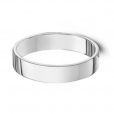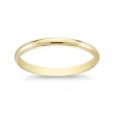The History of Welsh Gold
A rich and prestigious history is at the heart of Welsh Gold. What was once a source of wealth and currency to the Celts and Romans is now a part of tradition and cherished, rare jewellery.
A Timeline
Pre-Discovery
The presence of gold in Wales is attributed to volcanic activity over 500 million years ago. In Gwynedd, north-west Wales, the volcano Rhobell Fawr erupted from out the sea and formed new land mass which now makes up the majority of Snowdonia. The eruption brought about a large-scale metamorphoses of rocks and minerals, from which Wales gained its supply of gold.
Buried under land for thousands of years, the amounts of quartz, copper and gold, amongst other metals created, were untouched until relatively recently.
The Discovery of Gold
First discovered in the neolithic era approximately 3,000 years ago, gold was primarily obtained through panning until the invasion of the Romans in AD 47. From then, the Romans used their advanced method of mineral extraction to discover vast quantities of lead, copper and most importantly – gold. Whilst the main source of gold was originally located in Dolaucothi and the surrounding River Cothi, the Romans expanded its mining to other areas of the country. Until the fifth century AD, the Romans profited greatly from Dolaucothi, before abandoning Britain.
Before the Romans, the gold prospected by the native Celts was worked into jewellery and decorating weapons, amongst other uses. The Romans’ desire to mine it stemmed from the need to increase the amount of gold coins in their bank to fund continual expansion.
Following the Romans’ abandonment of Britain, mining of Welsh Gold was all but stopped until a resurgence of interest in the Victorian era. There is a possibility that mines in Mostyn and Blaenavon, though local speculation is little backed up by credible evidence and virtually no identifiable gold from these areas remain. What is certain, however, is that panning of gold was a widely-adopted activity in various Welsh regions and has remained the case until its decline in popularity, return and legality in the past few decades.
The Welsh Gold Renaissance
The revitalisation of the interest in Welsh Gold surfaced in the Industrial Revolution – with the discovery of mines in Gwynfynydd and Clogau (St David’s) in the Dolgellau region during the mid-1800s. Both were mined extensively until the 1990s and a combined amount of over 120,000 troy ounces of gold was obtained. This period of prosperity is referred to as the Welsh Gold Rush. There were over 30 other gold mines in the Gwynedd region in north Wales but none were as yielding as the Dolgellau gold-belt encompassing Gwynfynydd and Clogau St David’s.
In the 1900s, gold mining in Wales became quite sporadic and, at the early turn of the century, Gwynfynydd and Clogau began to close and re-open sporadically. In the 1980s, the two reopened and resulted in one of the most productive periods of procurement since the initial gold rush in the 1960s.
Welsh Gold became extremely popular within the UK’s Royal Family after Queen Elizabeth (The Queen Mother) had her wedding ring furnished from the Clogau St David’s mine. The tradition of using Welsh Gold in royal wedding rings has been continued. As a result, demand for Welsh Gold outstrips today’s supply.
Present Day
Welsh Gold has long since ceased to be produced – not for the past 15 years has any been extracted from any mines, which are now all shut down. In the late 1980s, a company called Britannia Gold had a contract with the licencees of the famous Gwynfynydd mine, near Dolgellau, under which they bought all the gold from the mine, refined it, selected and monitored where it was sold to, and made sure each piece bore their registered trademark, in the form of a Welsh Lady. Britannia sold its supply of Welsh Gold to just three jewellers – one of whom is Kelvin Jenkins. Britannia has now ceased to exist and the Gwynfynydd mine was later opened just once more in a more tourist-orientated capacity, by a different company, Gold Wales. That too has now ceased to exist.
In 1999, Gwynfynydd closed for the last time whilst Clogau St David’s was closed the year earlier. No gold mines in Wales are currently operational and, as a result, Welsh Gold is now extremely rare – the scarcity has resulted in the average price per troy ounce far exceeding the cost of gold from anywhere else in the world. This rarity means that there are two very important factors in defining the quality of present-day Welsh Gold jewellery: the carat and the actual amount of Welsh Gold present overall. Most “Welsh Gold” jewellery now on sale in shops is manufactured in China, and contains an unspecified “touch” of Welsh Gold. Kelvin’s Welsh Gold contains exactly 5% Welsh Gold and is made by hand, by himself, in his Machynlleth workshop.
A Guarantee of Gold
What is harder to distinguish is the amount of genuine Welsh Gold in each piece of jewellery. Many jewellers worldwide, including some of our competitors, claim to sell rings, neckalces and any other jewellery with ‘a touch of Welsh Gold’. Whilst perhaps true (though unverifiable), the percentage of genuine Welsh Gold is realistically far below 1% – and often less than 0.1% – and the rest is generic world gold bullion. The only way to be certain of the Welsh Gold percentage is to buy from a reputable supplier that can provide a certificate of authenticity stating the precise percentage of Welsh Gold content that makes up the piece of jewellery.
Our Welsh Gold, after being hallmarked by the Edinburgh Assay Office, using our makers mark KJ – unique to our Welsh Gold pieces – is stamped with our own punches to read Aur (Welsh for Gold) and A10%C, to give all our customers the utmost assurance of the amount of genuine Welsh Gold making up each piece of jewellery. We take the utmost care to ensure that this is always true, down to alloying the Welsh Gold mix in tiny 4 gramme ingots.
Tailored to Your Needs
We make every piece of jewellery from scratch, whether for our shop or specifically crafted to your request. As such, we are more than happy to accommodate requests for the increasing popularity of both Fairtrade and recycled gold. We can mix either, or both, in with our traditional Welsh Gold to create a beautiful, highly personal piece of jewellery.
Please feel free to ring Kelvin Jenkins on 01654 703370 to discuss your requirements.

 9ct Welsh White Gold 4mm Flat Band Wedding Ring
9ct Welsh White Gold 4mm Flat Band Wedding Ring  18ct Welsh Gold 5mm Cushion Fit Wedding Ring
18ct Welsh Gold 5mm Cushion Fit Wedding Ring  9ct Welsh Gold 2.5mm D Section Wedding Ring
9ct Welsh Gold 2.5mm D Section Wedding Ring  18ct Welsh White Gold 7mm Flat Band Wedding Ring
18ct Welsh White Gold 7mm Flat Band Wedding Ring  9ct Welsh Gold Narrow Plait Ring
9ct Welsh Gold Narrow Plait Ring